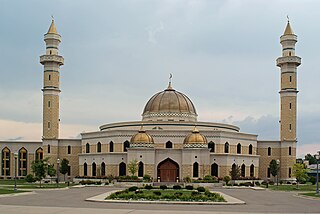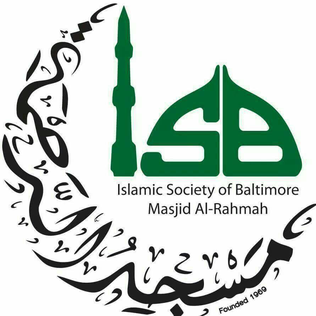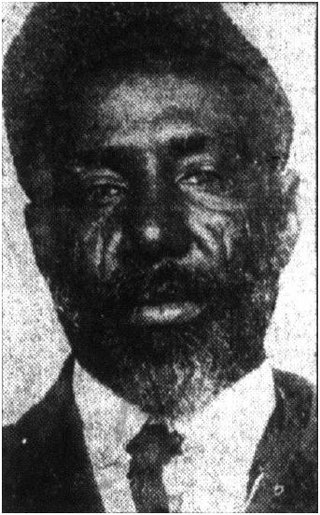The Five Pillars of Islam are fundamental practices in Islam, considered to be obligatory acts of worship for all Muslims. They are summarized in the hadith of Gabriel. The Sunni and Shia agree on the basic details of the performance and practice of these acts, but the Shia do not refer to them by the same name. They are: Muslim creed, prayer, charity to the poor, fasting in the month of Ramadan, and the pilgrimage to Mecca for those who are able.

Imam is an Islamic leadership position. For Sunni Muslims, Imam is most commonly used as the title of a prayer leader of a mosque. In this context, imams may lead Islamic prayers, serve as community leaders, and provide religious guidance. Thus for Sunnis, anyone can study the basic Islamic sciences and become an imam.

A mosque, also called a masjid, is a place of worship for Muslims. The term usually refers to a covered building, but can be any place where Islamic prayers are performed, such as an outdoor courtyard.
The Nation of Islam (NOI) is a religious organization founded in the United States by Wallace Fard Muhammad in 1930. A centralized and hierarchical organization, the NOI is committed to black nationalism and focuses on the African diaspora, especially on African Americans. While describing itself as Islamic and using Islamic terminologies, its religious tenets differ substantially from orthodox Islamic traditions. Scholars of religion characterize it as a new religious movement.

Hamtramck is a city in Wayne County in the U.S. state of Michigan. An enclave of Detroit, Hamtramck is located roughly 5 miles (8.0 km) north of downtown Detroit, and is surrounded by Detroit on most sides. As of the 2020 census, the city had a population of 28,433, and was by far the most densely populated municipality in Michigan. It is notable as the only Muslim-majority city in the United States.

Wallace Fard Muhammad, also known as W. F. Muhammad, W. D. Fard, Wallace D. Fard, or Master Fard Muhammad, among other names was the founder of the Nation of Islam.

The Night of Power, is, in Islamic belief, the night when Muslims believe the Quran was first sent down from heaven to the world, and also the night when its first verses were revealed to the Islamic prophet Muhammad; it is described as better than a thousand months of worshipping. According to various hadiths, its exact date is uncertain but was one of the odd-numbered nights of the last ten days of Ramadan, the ninth month of the Islamic calendar. Since that time, Muslims have regarded the last ten nights of Ramadan as being especially blessed. Muslims believe the Night comes again every year, with blessings and mercy of God in abundance. The surah al-Qadr is named after this night, and the purpose of the surah is to describe the greatness of the night.

Bab Zuweila or Bab Zuwayla is one of three remaining gates in the city walls of historic Cairo in Egypt. It was also known as Bawabat al-Mitwali or Bab al-Mitwali. The gate was built in 1092 by the Fatimid vizier Badr al-Jamali. The two minaret towers on top of it were added between 1415 and 1422 as part of the construction of the adjacent Mosque of Sultan al-Muayyad. Today it remains one of the major landmarks of Cairo.

Timothy John Winter, also known as Abdal Hakim Murad, is an English academic, theologian and Islamic scholar who is a proponent of Islamic neo-traditionalism. His work includes publications on Islamic theology, modernity, and Anglo-Muslim relations, and he has translated several Islamic texts.

Mohammed Alexander Russell Webb was an American writer, publisher, and the United States Consul to the Philippines. He converted to Islam in 1889, and is considered by historians to be the earliest prominent Old Stock American Muslim convert. In 1893, he was the sole person representing Islam at the first Parliament of the World's Religions.
David Wood is an American evangelical apologist, philosopher and YouTube personality, who is the head of the Acts 17 Apologetics ministry, which he co-founded with Nabeel Qureshi. He also runs Foundation for Advocating Christian Truth, which is the organization behind AnsweringMuslims.com. Wood is known for his criticism of Islam, particularly Islamic views on theology and morality, as well as the Quran in general, hadith, sīrah and Muhammad.

The Detroit metropolitan area has one of the largest concentrations of people of Middle Eastern origin, including Arabs and Chaldo-Assyrians in the United States. As of 2007 about 300,000 people in Southeast Michigan traced their descent from the Middle East. Dearborn's sizeable Arab community consists largely of Lebanese people who immigrated for jobs in the auto industry in the 1920s, and of more recent Yemenis and Iraqis. In 2010 the four Metro Detroit counties had at least 200,000 people of Middle Eastern origin. Bobby Ghosh of TIME said that some estimates gave much larger numbers. From 1990 to 2000 the percentage of people speaking Arabic in the home increased by 106% in Wayne County, 99.5% in Macomb County, and 41% in Oakland County.
The organization Global Detroit stated that the largest group of ethnic Albanians not in Europe is in Metro Detroit. As of 2014, 4,800 ethnic Albanians live in Macomb County, making up the fourth-largest ethnic group in that county, and the highest concentration of Albanians in Metro Detroit. There are also several thousand in Wayne County, with most living outside Detroit city limits; Hamtramck and St. Clair Shores are plentiful in Albanian American and Kosovar-Albanian American communities. There are at least ethnically 30,200 Albanian people in Michigan, consistuting 0.3% of Michigan's population.

Islam is practiced by several Muslim American groups in Metro Detroit.

Ahmadiyya is an Islamic branch in the United States. The earliest contact between the American people and the Ahmadiyya movement in Islam was during the lifetime of Mirza Ghulam Ahmad. In 1911, during the era of the First Caliphate of the Community, the Ahmadiyya movement in India began to prepare for its mission to the United States. However, it was not until 1920, during the era of the Second Caliphate of the Ahmadiyya movement, that Mufti Muhammad Sadiq, under the directive of the caliph, would leave England on SS Haverford for the United States. Sadiq established the Ahmadiyya Muslim Community in the United States in 1920. The U.S. Ahmadiyya movement is considered by some historians as one of the precursors to the Civil Rights Movement in America. The Community was the most influential Muslim community in African-American Islam until the 1950s. Today, there are approximately 15,000 to 20,000 American Ahmadi Muslims spread across the country.
Islamophobia/Islamophilia: Beyond the Politics of Enemy and Friend is a 2010 book edited by Andrew Shryock, published by Indiana University Press.

The Islamic Society of Baltimore (ISB) is a Muslim community center located in Catonsville, Baltimore County, Maryland, consisting of Masjid Al-Rahmah, Al-Rahmah School, and several other services. The society was founded in 1969 by three Muslim physicians and is known for then-President Barack Obama's visit on February 3, 2016. As of 2019, the society serves around 3,000 people.
Daniel Gibson is a Canadian author studying the early history of Arabia and Islam. He is the author of Early Islamic Qiblas: A survey of mosques built between 1AH/622 C.E. and 263 AH/876 C.E, which advances the claim that early mosques were oriented towards Petra, rather than towards Mecca or Jerusalem as traditionally accepted by archaeologists and historians of Islam.

Sherin Khankan is Denmark's first female imam; she founded a women-led mosque in Copenhagen. She is also an activist on Muslim issues including female integration and extremism, and has written numerous texts discussing Islam and politics.

Imam Satti Majid, also known as Shaykh al-Islam in North America, was a Sudanese Islamic leader who is considered as one of the first Muslim missionaries in the United States and known for establishing Islam as an organised religion in the United States during the interwar period. Satti Majid Muhammad al-Qadi Suwar al-Dhahab was from a Dongolawi family of religious judges and clerics. He studied Islam in a khalwa, then pursued education at al-Azhar University in Egypt. With intentions to spread Islam, he moved to England, where he co-founded the Islamic Missionary Society with fellow Dongolawi and Yemeni men, delivering speeches and lectures across Britain, where he used his knowledge in Quran and Hadith while his associates translated to English.














